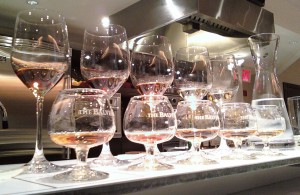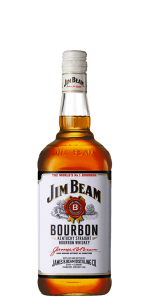Balvenie 17yo Retrospective

Friday night, Sam Simmons (known as to some) hosted a class at Astor Center, titled “The Influence of Wood Finishing on Whisky: A Retrospective of The Balvenie 17yr.” Needless to say, I was excited when I first heard about this event. Since the release of Glenmorangie’s line of wood finishes, I have dreamed of either hosting or attending a class where participants were given the opportunity for side by side tastings of variously finished whiskies. In my head, this class would include tastings of the finishing barrel’s previous contents. Sam, it seems, is of a same mind. Although he used the various Balvenie 17yo releases instead of the Glenmorangie that sparked the idea in my head, I could not have been more thrilled (he is the Balvenie brand ambassador for the US after all).
Sam started the night with little history about the Balvenie and why it is his favorite distillery (family owned, they grow their own barley, they malt their own barley, employ their own coopers and copper smiths, and of course Master Distiller/Blender David Stewart). Now you may say, “but Matt, he’s the brand ambassador, doesn’t he have to say these thing?” Well, yes and no. He tells the truth on all accounts. The list above is what makes the Balvenie stand out among the myriad of distilleries sprinkled about Scotland. Furthermore, Sam asserts that his love of the Balvenie started long before he became an employee of William Grant and Sons. I think we can trust him on this.
Roughly 70% of whisky’s flavor comes from the barrel. This is why the type of barrel is so important in the initial maturation and finishing of the product. To that end, Sam started the evening with some neutral spirits straight from the still. Not straight from the still exactly, the spirits had been cut to 63% ABV as that is what goes into the barrel for aging. If you have ever had grappa or moonshine, you have an idea what this tastes like. The nose smelled faintly of fruit with heavy cereal and alcohol notes. The taste? Well, the alcohol is strong with some malty goodness buried in the back.
Next we moved onto the actual whisky. David Stewart created a firestorm in the whisky industry back in 2000/2001 with the introduction of the Balvenie Islay Cask. Industry insiders, enthusiasts, and casual drinkers were giddy with this “best of both worlds” style bottling. David being an adventurous man, he responded with, not more Islay cask, but with a New Wood release in 2005/2006. Since then, New Oak, Sherry Oak, and Rum Cask have all hit the market. Apart from the Rum Cask (released just last year), the whiskies are very difficult to find and have become collector’s items. How any man can buy a bottle of whisky and just look at it, I’ll never know. Our tasting moved in reverse chronological order.
The Balvenie 17yo Rum Cask spent four months in Jamaican rum casks after 17 years in traditional oak. This is an excellent dram, but I was hoping for something a little more akin to the Glenfiddich 21yo Rum Cask. Where the Glenfiddich is well balanced, the Balvenie is a little too sweet for my palate. It is almost cloying in its sweetness. Perhaps this is a function of age, but I think that the deeply honeyed nature of the Balvenie just goes over the edge here (slightly). We tried this along with Appleton Estates Jamaican Rum (one of my favorites). Sam could not confirm the source of the Jamaican rum casks used at the Balvenie, but we were still able to tasted the lineage of this whisky. The rum imparts the smells and flavors of bananas and coconuts to the already sweet whisky. If you’ve ever wanted to taste a whisky that smells like a banana split, here’s your chance.
For the Sherry Oak release, the whisky spent all 17 years in Oloroso sherry butts. I am not a sherry drinker. However, I tend to like whiskies produced in this manner (the Macallan, the Glenrothes). I was interested to see how the Balvenie would hold up to the sherry. I have to say, it was a let down for me. Once again, we have a balance problem. The whisky smelled delightful (like baked apples). However, the palate was overly sherried for me. The proof of the connection was provided by a glass of Oloroso sherry. After a few sips back and forth, I was sure that the sherry was holding the whisky back.
The New Oak release was quite an experiment. First David Stewart vatted 17yo whisky from sherry casks and bourbon casks. Then, he aged the vatted whisky in new toasted oak casks for four months. My favorite whiskey so far, the nose was like creme brulee with traces of mint. The palate had mint and the traditional honeyed tones morphed into agave and maple syrup. We tried this with a 12yo Elijah Craig bourbon (a good dram by itself). Once again, Sam cannot verify the source of the barrels used in the production of this whisky, but he says that he has seen Heaven Hill (the producers of Elijah Craig) barrels around the warehouse. That is why he chose this particular bourbon to supplement the tasting.
The New Wood release, featured whisky aged first in barrels that previously held Balvenie whiskey then in new oak barrels. This is a real wine drinker’s whisky (bright, citrusy, oak and honey). Tried next to a very oaky Chardonnay, this whisky stands out as unique and interesting. Not a bold whisky by any means, but a good whisky to complement food or to tempt a wine drinker from vine to grain.
Finally, we reached the Islay Cask. This whisky is long gone from store shelves and is now relegated to online auctions and collector’s cabinets. It is really a shame though. This is the best of the five releases so far, and you can see (taste) why this created such an uproar when released. We tasted this with Laphroaig 10. Laphroaig is highly peatly and not very well balanced, but it is reasonable to assume that Laphroaig or something similar slept in these casks before they held 17yo Balvenie. The alchemy of this release is really interesting. The nose is honeyed smoke, like a bonfire on the beach at dusk as the wind carries scents of honeysuckle from the shore. The palate carries on the smokey sweetness and adds butter toffee and citrus. Truly a delightful whisky.
I am grateful to Sam Simmons for offering this class. It was really a dream come true for me. Although I curse him for giving me the opportunity to fall in love with another whisky that is beyond my grasp.
After the “Blend Your Own Balvenie Signature Reserve” class, one of our readers asked if there were any plans to take that class to the UK. Well Ian, I’m afraid neither that class nor this one will be offered over there. These classes were both stocked from Sam’s personal collection. Sorry folks.
Drink well. Drink responsibly.
-Matt



